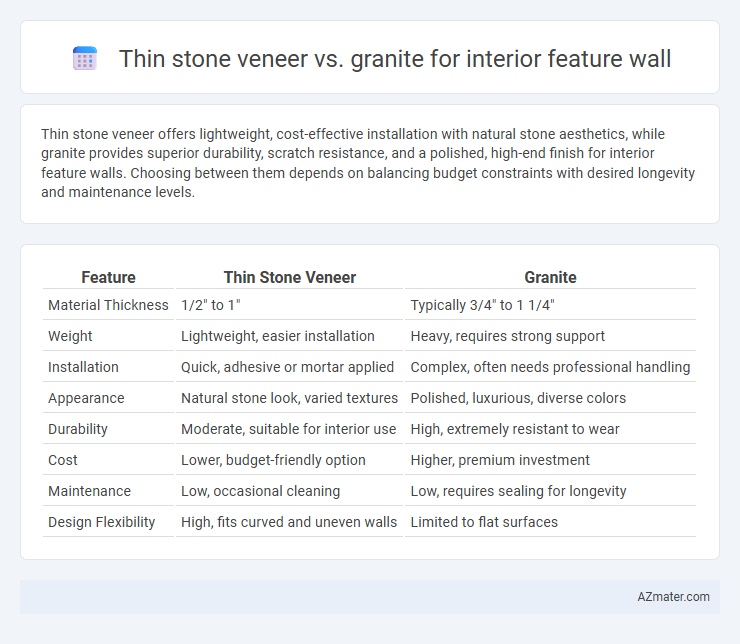Thin stone veneer offers lightweight, cost-effective installation with natural stone aesthetics, while granite provides superior durability, scratch resistance, and a polished, high-end finish for interior feature walls. Choosing between them depends on balancing budget constraints with desired longevity and maintenance levels.
Table of Comparison
| Feature | Thin Stone Veneer | Granite |
|---|---|---|
| Material Thickness | 1/2" to 1" | Typically 3/4" to 1 1/4" |
| Weight | Lightweight, easier installation | Heavy, requires strong support |
| Installation | Quick, adhesive or mortar applied | Complex, often needs professional handling |
| Appearance | Natural stone look, varied textures | Polished, luxurious, diverse colors |
| Durability | Moderate, suitable for interior use | High, extremely resistant to wear |
| Cost | Lower, budget-friendly option | Higher, premium investment |
| Maintenance | Low, occasional cleaning | Low, requires sealing for longevity |
| Design Flexibility | High, fits curved and uneven walls | Limited to flat surfaces |
Introduction to Thin Stone Veneer and Granite
Thin stone veneer offers a lightweight, cost-effective alternative to traditional stone, providing natural texture and appearance without the substantial weight of solid stone slabs. Granite, a dense and durable igneous rock, is prized for its unique grain patterns, high resistance to scratching and heat, and long-lasting durability in interior feature walls. Selecting between thin stone veneer and granite depends on factors including installation complexity, maintenance requirements, and desired aesthetic impact in interior design.
Material Composition and Characteristics
Thin stone veneer consists of natural stone slices typically 1/2 inch thick, offering lightweight, flexible installation ideal for interior feature walls, with good thermal insulation and moisture resistance. Granite, a coarse-grained igneous rock composed mainly of quartz, feldspar, and mica, provides superior durability, hardness, and scratch resistance, making it a long-lasting material for high-traffic interior accent walls. The choice between thin stone veneer and solid granite hinges on balancing ease of installation and weight against premium strength and natural mineral variation for aesthetic appeal.
Visual Appeal and Design Versatility
Thin stone veneer offers a textured, natural look with lightweight flexibility, allowing easy application on various interior surfaces and intricate designs. Granite provides a polished, luxurious appearance with unique veining patterns and a broader color range, enhancing high-end aesthetic appeal. Both materials add distinct visual depth, but thin stone veneer excels in design versatility while granite stands out for its elegance and durability in feature walls.
Installation Process and Techniques
Thin stone veneer offers lightweight properties and ease of installation, often adhering to drywall or plywood using mortar or construction adhesives, allowing for quicker application and less structural support compared to granite. Granite slabs require specialized tools and experienced labor for cutting, handling, and anchoring, often involving mechanical fasteners or mortar on reinforced substrates to manage their substantial weight. Both materials demand proper substrate preparation, moisture barriers, and sealing techniques to ensure durability and aesthetic appeal in interior feature wall installations.
Weight and Structural Considerations
Thin stone veneer typically weighs between 10 to 15 pounds per square foot, making it significantly lighter than traditional granite slabs, which can weigh around 18 to 20 pounds per square foot. This reduced weight allows thin stone veneer to be installed on a wider range of substrate types with less need for additional structural reinforcement, making it ideal for interior feature walls in both residential and commercial applications. Granite's heavier weight necessitates stronger support systems and careful consideration of wall framing and anchoring to prevent structural issues over time.
Cost Comparison: Thin Stone Veneer vs Granite
Thin stone veneer offers a cost-effective alternative to granite, with prices typically ranging from $6 to $12 per square foot, including installation, compared to granite's $40 to $100 per square foot, depending on grade and thickness. The lighter weight of thin stone veneer reduces labor and structural reinforcement costs, making it suitable for interior feature walls without significant modifications. Granite demands higher upfront investment and maintenance expenses, impacting overall budget considerations for long-term projects.
Maintenance Requirements and Durability
Thin stone veneer requires minimal maintenance, typically only periodic dusting and sealing every few years to prevent moisture penetration, making it highly practical for interior feature walls. Granite offers exceptional durability with natural resistance to scratches, stains, and heat, though it also benefits from regular sealing to maintain its polished appearance and prevent etching. Both materials provide long-lasting solutions, but granite's higher density and hardness deliver superior robustness in high-traffic or impact-prone interior areas.
Environmental Impact and Sustainability
Thin stone veneer offers a lower environmental footprint than granite, as it requires less quarrying and transportation due to its reduced thickness and weight. Granite extraction leads to significant habitat disruption and higher carbon emissions, whereas thin veneer utilizes smaller stone slices, minimizing resource depletion. Choosing thin stone veneer enhances sustainability by reducing material waste and energy consumption during installation and shipping.
Suitability for Different Interior Styles
Thin stone veneer offers versatile design options ideal for rustic, modern farmhouse, and Mediterranean interior styles due to its lightweight nature and natural texture. Granite provides a sleek, polished surface suitable for contemporary, minimalist, and luxury interiors, enhancing durability and elegance. Selecting between thin stone veneer and granite depends on balance between textural warmth and refined sophistication tailored to the specific interior aesthetic.
Choosing the Right Option for Your Interior Feature Wall
Thin stone veneer offers a lightweight, cost-effective alternative to granite for interior feature walls, providing natural stone aesthetics with easier installation and greater versatility. Granite delivers unmatched durability, scratch resistance, and a polished, luxurious appearance, making it ideal for high-traffic areas or spaces aiming for a premium finish. Selecting between thin stone veneer and granite depends on your budget, desired texture, maintenance preferences, and the overall design theme of your interior space.

Infographic: Thin stone veneer vs Granite for Interior feature wall
 azmater.com
azmater.com